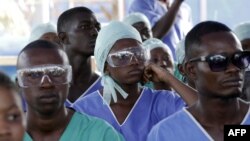Doctors Without Borders has opened an Ebola treatment ward for pregnant women in Sierra Leone. It is the first of its kind. Sierra Leone already had one of the highest maternal mortality rates in the world before Ebola arrived. Health workers say the situation has gotten worse, as women with Ebola face an even higher risk of hemorrhaging while giving birth.
Pregnant women in Sierra Leone, who are confirmed or suspected of having Ebola, can now receive specialized care at a new maternity ward in the suburbs of Freetown.
Studies from previous outbreaks in the Democratic Republic of Congo have shown that at least 95 percent of pregnant women with Ebola die.
The babies almost never survive. Most are stillborn.
“I must stress that too little is known about Ebola infections in general. There are more questions than answers, and this applies even more so to pregnant women," said Marcus Bachmann, head of mission for Doctors Without Borders’ (MSF) in Sierra Leone. "But what we have so far observed, unfortunately, is that the virus manages to cross the placenta, and actually, as a matter of fact, the highest viral load ever found and ever tested in samples of patients is found in the amniotic fluid, in the umbilical cord and in the fetus.”
Bachmann said the immune systems of pregnant women are believed to react differently to the Ebola infection, making it harder for them to fight the virus.
When they go into labor, Ebola heightens the risk of uncontrolled bleeding.
The new maternity ward is equipped to deal with these issues. MSF says it offers the highest level of infection control, specially trained staff and midwives, as well as antibiotics and antihemorrhagic medications for the mother.
The specialized unit includes four delivery rooms, as well as a separate area with 33 beds for pregnant women to stay who are not yet ready to give birth. It is also equipped with cameras so that medical staff can keep an eye on women in labor.
“With the full PPEs [personal protective equipment], the number of entries and the amount of time a team can spend in the ward is limited to a maximum of 50 minutes. After that, the team needs to exit. With this new technology, we can much, much better increase the monitoring of these pregnant women,” said Bachmann.
Bachmann added the doctors, nurses and midwives who treat pregnant women are at an even higher risk of contamination than when treating other patients. Ebola is spread through contact with bodily fluids, something that is difficult to avoid during the birthing process.
He said it is hoped that this maternity ward will reduce the mortality rate among both expecting mothers and health care workers, as well as give more insight into how Ebola affects pregnant women.








